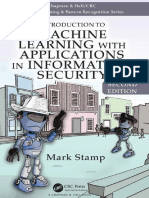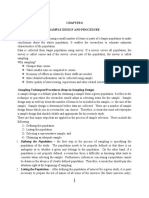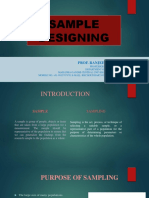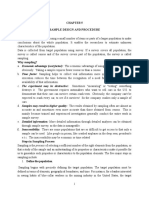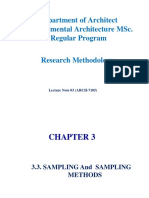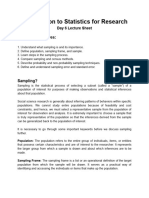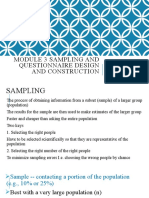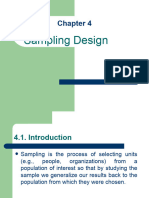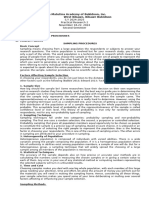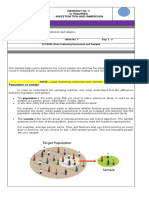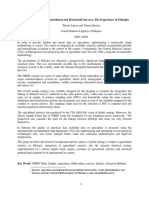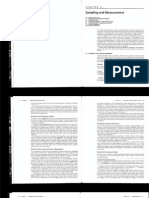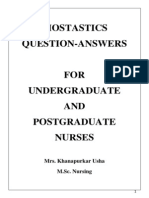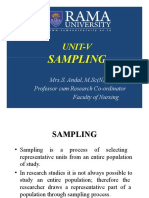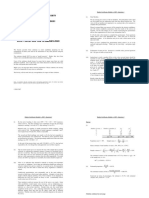Unit Sampling: Structure
Unit Sampling: Structure
Uploaded by
romesh10008Copyright:
Available Formats
Unit Sampling: Structure
Unit Sampling: Structure
Uploaded by
romesh10008Original Title
Copyright
Available Formats
Share this document
Did you find this document useful?
Is this content inappropriate?
Copyright:
Available Formats
Unit Sampling: Structure
Unit Sampling: Structure
Uploaded by
romesh10008Copyright:
Available Formats
UNIT 12 SAMPLING
Structure
12.1 12.2 12.3 12.4 Introduction Objectives Meaning of Population and Sample Methodsl'esigns of Sampling
12.4.1 12.4.2 12.4.3 Probability Sampling Non-probability Sampling Criteria for Selecting Sampling
12.5
Probability Sampling
125:l 12.5.2 12.5 3 12.5.4 1255 Simple Random Sampling Systematic Sampling Stratified Sampling Cluster Sampling Multi-stage and Multi-phase Sampling
12.6
Non-probability Sampling
12.6.1 12.6.2 12.6.3 Incidental Sampling Purposive Sampling y t a Sampling
12.7 12.8 12.9
Characteristics of a Good Sample Let Us Sum Up Unit-end Activity
12.10 Point For Discussion 12.1 1 Suggested Readings
12.12 Answers to Check Your Progress 12.13 Glossary
12.1 INTRODUCTION
In Unit 11, we have discussed the meaning and type of hypothesis. We also know by this time that testing the hypothesis is central to the research. In order to accomplish this it is imperative to collect requisite, recent and most relevant data. This helps us to decide from whom and how to collect these data. The primary purpose of research is to discover principles that have universal application. But to study a whole population in order to amve at generalizations would be impracticable if not impossible. Some populations are so that their characteristics cannot be measured, because before the measurement could be completed, the populations would have changed. Imagine the difficulty of conducting an experiment with all fifth-gradeIndian children [as subjects] on numerical ability. The study of this population would require the services of thousands of researchers, the expenditure of millions of rupees and thousands of class hours. In view of this it becomes imperative to collect the data from a smaller group of the population instead of collecting from the whole population.
30
There are various ways to achieve this. We will discuss these in this unit.
12.2
OBJECTnTES
Sampling
After completing the study of this unit, you will be to : define the terms 'population and sample', justify the need of selecting a sample, explain the meaning of probability sampling, describe various probability sampling methods, explain the meaning of non-probability sampling, describe various non-probability sampling methods, state the characteristics of a good sample.
12.3
MEANING OF POPULATION AND SAMPLE
A "population" is any group of individuals /units that have one or more characteristics in common which are of interest to the researcher, for a particular research. A population may include all the individuals of a particular type or a more restricted part of that group, e.g. a group of all the university teachers, or a group of male / female university teachers, or distance learners enrolled with IGNOU. For assessing the study habits of adolescent girls in city, all the adolescent girls of that city who are studying in schools and colleges, make up the population for this study. A "sample" is a small proportion of a population selected for the study. By observing the characteristics of the sample, one can make certain inferences about the characteristics of the population from which it is drawn. The term sampling refers to the strategies which enable us to pick a subgroup from a larger group and then use the subgroup as a basis for making judgement about the larger group. In order to use such a subgroup to make decisions about the larger group, the subgroup has to resemble the larger group as closely as possible.
12.4 METHODSIDESIGNS OF SAMPLING
In the earlier section we studied the concept of sampling. Now we shall study different
sampling methods. The sampling method was used in social sciences research as early as in 1754 by A.L. Bowley. Since then the method is increasingly used. The sampling methods are broadly classified into two types: (i) Probability sampling and (ii) Non probability sampling
12.4.1 Probability Sampling
Probability Sampling is based on some statistical concepts such as the 'Law of Large Numbers', 'Central Limit Theorem and the Normal Distribution' etc. In this type of sampling, the units of the population are not selected at the discretion of the researcher, but by means of certain procedures which ensure that every unit of population has one fixed probability fo being included in the sample. It is also called random sampling. The Law of Large Number states that as the sample size becomes large, probability that the estimate differs from the parameter to a greater extent, becomes small. Or in other words a larger number provides a more precise measure of the parameter under consideration. However, one precaution must be taken. While increasing the size of the sample care should be taken to maintain the representiveness of the sample, because a large sample does not automatically guarantee representiveness.
31
As per the second concept, sampling distribution approaches normal distribution provided - more the irregular distribution in the population, larger is the sample and sample is selected to avoid biases.
12.4.2 Non-probability Methods
The non-probability methods are based on the judgements of the investigator as the most important element of control. The guiding principles in non-probability methods are - availability of the subjects, the personal judgement of the investigator, and convenience in carrying out the research.
12.4.3 Criteria for Selecting Sampling
i) Because there are various sampling methods it becomes crucial to select appropriate sampling method. Young has suggested three criteria to be considered while selecting a sampling method A measurable or known probability sampling technique should be used to control the risk of errors in the sample estimate.
ii)
Simple, straightforward and workable methods, adapted to available facilities and personnel, should be used. Achieving optimum balance between expenditure incurred and maximum of reliable information should be the guiding principle.
The decision whether a probability sampling or a non -probability sampling is to be applied rests on the constraints which are not very different from those stated earlier. These are - objectives of the study, type of study and availability of the resources for the study. If the objective of the research is to apply the results of the study to a small local group then sampling may not be given as much consideration as in a study the results of which are to be applied to a larger group. In experimental research internal validity is of more concern than the external validity.
Action research generally does not require sampling from a larger group. Most of the times sampling is not very essential in historical research also. Whereas survey studies generally have a more rigorous sampling. The availability of time, funds, manpower and equipment required is another importantconsiderationin deciding about the size and technique of sampling.
iii) If one is interested in obtaining an estimate of the sampling error, one may resort to probability sampling rather than to a non-probability one.
Check Your Progress
Notes: a) Space is given below for writing your answer. b) Compare your answer with that given a the end of the unit. t
1.
State the meaning of the following terms: Population, Sample, ProbabilitySampling,Non-pmbability Sampling.
.............................................................................................................. .............................................................................................................. .............................................................................................................. .............................................................................................................. .............................................................................................................. ..............................................................................................................
32
12.5
PROBABILITY SAMPLING
Sampling
We know the meaning of and requirement for probability sampling. Now we will take a brief account of different methods of probability sampling.
12.5.1 Simple Random Sampling
Theoretically, this is a method of selecting 'n' units from N units in such a way that everyone in the population of N units, has an equal chance of being selected. This can be done through the following steps defining population by specifying its various limits. preparing the sampling frame. incorporating the names or serial numbers of individual units in the sampling frame (every unit is to be listed, order does not make any difference). It is important to note that random sample is not necessarily as identical representation of the population. After this, to get the required 'n' units different techniques are available. Let us get acquainted with these techniques one by one.
i) Lottery Method After naming or numbering every unit in the population, they are well mixed. The required numbers of units are then drawn from all these well-mixed chits. The individualslobjects with these identification namednumbers are then picked up for inclusion in the sample.
However this technique has some objections. When the population is very large and includes such individuals/objects, which are of such nature that could not be mixed and further if 'well mixing' is not attained despite all efforts,the principle of randomness in the population may be violated.
ii) Random Table Method
Research Design
will be too cumbersome to recommend in case of large population. In such situation, computer generated random selection should be resorted to, in order to save time and labour. Tables of random numbers have been generated by computers producing a random sequence of digits e.g. random digit table by Rand Corporation and prepared by Kendall & Smith, by Fisher & Yates and by Tippett are frequently used. The required number of units are selected from such a table in any convenient and systematic way. Now suppose we have select to 20 distance learners for interview from 80-distance learners registered at a study centre. We may start with any column and any row. Because we want 20 numbers i.e. two digit numbers, we have to select only the first two digits from each number. If we select the first column and start from first row then we will get following twenty two digit numbers - 23,05, 14,38,97, 11, 43, ................ 61. You will notice that numbers greater than 80 will have to be deleted from this list and for the remaining numbers selecting any other column and the row the procedure will have to be repeated, till we get required number i.e. 20. If any number is repeated in this list, it is to be substituted by selecting the next number. Until a sample of desired size is obtained, the selection procedure is to be continued. Advantages 1. This method calls for no special expertise and training or even insight. It can be used mechanically by anybody.
However, best results are achieved by adopting simple random sampling method. Still, it is not free from criticism. Limitations Practically listing of all the units in the population may not be possible.
1.
In case of population with infinite numbers, listing is out of the question. It is difficult though not impossible, but it involves high cost. In case of heterogeneous population the selected random sample may not truly represent the characteristics of the population.
2. 3.
12.5.2 Systematic Sampling
A variation of the random process of sampling is the systematic sampling. It is the selection of the required number of elements of the population to include in the sample. It involves the following steps : Listing the population elements in some order, say alphabetically, meritwise etc. Determining the desired number to be selected from the population e.g. 10 % of 1000 means 100 out of 1000. Starting with any number from among the numbers 1 to 10 (i.e. 1 to k, both inclusive), to select every 10" (or k") element from the list. If the number chosen from 1 to 10 is 4 , then the selected numbers will be the 4", 14Ih,24", ......,994" elements making the sample with 100 elements. As the elements are chosen from regular intervals, this technique is also known as sampling by regular intervals, this technique is also known as sampling by regular intervals, sampling by fixed intervals or sampling by every k*unit. Advantages 1 . It is more practical in that it involves less labour. 2. 3. Because it is simpler to perform, it may reduce errors. The procedure is speedy in comparison with simple random sampling.
4.
The systematic sample is spread more evenly over the population which makes this method more precise than stratified random sampling.
Sampling
Limitations
I. Selection of every element other than the first selected randomly is linked with the first element. This makes the process different from the simple random method where selection of every element is independent of other one. When the list of elements has a periodic arrangement, there is a risk that the sample interval may coincide with the periodic interval in the list. Suppose, A, B, C, D and E are the 5 schools selected and from each school 100 students are selected. The students from school A are placed starting from 1, from school B starting from 2, from school C starting from 3, from school D starting from 4 and from school E starting from 5 with an interval of 5. Thus the school A students will hold the numbers 1,6,11,16,21,........496. The school B students will hold the numbers 2,7,12,17,22,. .........497. Now in systematic samplingprocedure suppose we decide to select 5 % of the total and randomly choose any number from 1 to 5 say '3' then starting from 3 we will have to select every 5" number. These numbers will be 3,8,13,18.. ......498. Have you noticed that all these numbers belong to school C? Why has it happened so?
The answer is Because every school is repeated in the list with an interval of '5' and elements are selected with an interval of ' 5 ' .
3.
Another limitation of the systematic sampling method is the trend of the listed population. This is explained below -
Suppose 100 students are listed in the decreasing order of academic merit. We want to draw a sample of 20 students from this using systematic sampling method. 20 out of 100 means the size of interval is ' 5 ' . We can draw many samples from this listed population. If we randomly pick up a number from amongst 1 to 5, say 3 then the ,sample will comprise the elements 3"', 81h, 13", 18Ih..... .......981h instead , if we . randomly pick '5' then the sample will comprise the 5"', loth,151h-,............,100" elements. Is it not obvious that the two samples will not be comparable in terms of merit ? The mean average of these two samples would be significantly different with respect to merit and other associated variables. Calculations made from such samples cannot pinpoint the sources of variability.
12.5.3 Stratified Sampling
One question may arise in your mind is that : How to increase the precision of the sample? By increasing the size of the sample, its precision can be increased. But this is not the only way. Let us see which is the other one. It is the 'stratified sampling'. The term 'stratified' is very much self-explanatory.It involves dividing the population into such sub-populations(strata) that each one of them is homogeneous within itself. The steps to be followed in this method are as under deciding upon one or more characteristics on the basis of which strata will be formed e.g. location of schools - mral, urban, suburban, urban-slums, metropolitan etc.
dividing the population under consideration into strata on the basis of stratification characteristics/criteria. listing the units in each stratum separately.
F
35
ResearchDesign
selecting requisite number of elements from each stratum using appropriate random selection technique.
Thus all the elements selected from all the strata compose the required sample. Important points to be noted i) ii) iii) The criteria for dividing the population into strata should be correlated with the variable being studied. The criteria should be practical. It should not yield a unwieldy number of strata.
A good measure of the stratification criteria should be available; e.g. if reliable and valid tool of determiningsocioeconomic status is not available ,stratification on this basis would lead to confounding of the results.
iv) Selection of the elements at random from each stratum in the same proportion as that of the actual size of the stratum in the population improves the representativeness of the sample and helps in achieving higher efficiency at a reduced cost. v) In some studies (like census) stratification is not possible before the data have been collected. After collecting the data stratification as per sex, age, educational level is effected. Or a simple random sample of the required size is selected and the classification into strata is observed.
Advantages
I.
2.
Stratified random sampling is very useful when a list of the elements in the population is not available. It is the most applicable method of sampling when the population is heterogeneous.
12.5.4 Cluster Sampling
When listing of population or at least the total strength of the population is possible and available or in other words when the population is finite we saw that the sampling methods applicable were - simple random, systematic or stratified random sampling. But what to do when the population is infinite ? In such a case ,the method applicable is called as 'cluster sampling'. Cluster sampling is used when the population under study is relatively infinite, where the list of the elements is not available, the elementsiunits are geographically scattered or when sampling of individual elements is not required or is not convenient.
A cluster is an intact group as available in the field. It is not formed by the researcher
for the purpose of data collection. For example a school complex (a group of schools) is a cluster. Some such clusters are selected to make a sample. Here a sampling elementtunit is a group/cluster. In social survey, the cluster sampling is described as 'area sampling'. This method involves following steps -
deciding the nature of the cluster required. indentifyingnocating such clusters to make the population. selecting the clusters in required number at random.
Advantages
This method of sampling is economic, especially when the cost of measuring a unit is relatively small.
Limitations When the sampling unit is to be an individual elementtunitor number in the population, this method is not applicable.
12.5.5 Multi-stage and Multi-phase Sampling
In the multi-stage sampling selection of different types of sampling units such as some Districts in a State, some Taluka places in those Districts and then some schools ,is involved at different sampling stages. Whereas in the multi-phase sampling, the researcher is concerned with the same type of sampling unit at each phase but some members are asked for more information than others, e.g. information regarding study habits of distance learners can be collected from 100 distance learners through a questionnaire and 20 out of them can be interviewed for more information. The main distinction between the multi-stage and the multi-phase sampling is the use of unit of sampling at different levels.
Advantages
1. 2. 3. 4. In both the methods burden on respondents is reduced. Relative cost also gets reduced. Two-phase sampling is useful in studying rare cases. In two-phase sampling resulting gain in precision is more due to possibility of getting more information in details.
Check Your Progress Notes: a) Space is given below for writing your answers. b) Compare your answers with those given at the end of the unit.
2. Match the Pairs. I) Sampling Method i) Simple Random ii) Systematic
iii) Cluster
iv) Stratified random 11) Sampling Method i) Stratified random ii) Simple random iii) Systematic iv) Cluster
Limitations a) Samplingunit is not an individual element b) Not applicable to heterogeneous population c) Listing the elements in sub-population necessary d) Periodic arrangement of elements e) Periodic arrangement of elements Special Feature a) Every unit in the population has equal chance of being selected b) Spread more evenly over the population C) Useful in case of heterogeneous population d) Applicable in case of infinite nopulation
e) Same type of sampling unit at each phase 3. Distinguish between multi-stage and multi-phase sampling methods.
................................................................................................................. ................................................................................................................. .................................................................................................................
Research Design
12.6 NON-PROBABILITY SAMPLING
In 12.4.2 earlier we have understood the meaning of non-probability sampling. It is reiterated here. Where the selection of the units in the sample is based on the researcher's judgement and not on equal or known probability, it is the non-probability sampling method. A non-probability sample is termed as 'non-random sample' due to the very fact that it is selected through non-random method. The main feature of such a sample is the lack of control of the sampling error on account of which this method of sampling is referred to as 'uncontrolled sampling' method. This description of the non-probability sampling should not be taken in negative sense. In spite of all this many a times it is the demand of the situation to go for non-probability sampling method. Let us now study the different non-probability sampling methods one by one.
12.6.1 Incidental Sampling
Incidental Sampling is also known as accidental or convenience sampling. When a readily or easily available group is selected as a sample, it is termed as an 'incidental sample'. A teacher-educator e.g. may select the students from a school situated in the same campus which serves as a practicing school for the concerned college of education, to experimentally find the effectiveness of concept attainment model to teach a mathematical concept say, a quadrilateral.
Advantages
The administrative convenience of obtaining sample for the study, the ease of testing, saving in time, completeness of the data collected are some of the merits of this method.
Limitations
Since there is no well-defined population and no random sampling method is applied to select the sample, the standard error formulae apply with a high degree of approximation. Hence no valid generalization can be drawn. Any attempt at generalization based on such data and conclusion thereof will be misleading.
12.6.2 Purposive Sampling
Another non-probability sampling method is 'purposive sampling'. In this method samples are expressly chosen because in the light of available information they resemble some larger group with respect to one or more characteristics. The controlsfcriteriafor categorization in such samples are usually identified as representative areas such as a state, a district, a city etc or representative characteristics of individuals such as age, sex, socio-economic status etc. or representative types of groups such as elementary school teachers, secondary school teachers, college teachers, university teachers etc. These controlsf criteria may be further sub- divided e.g. the group of college teachers can be divided into male and female teachers or teachers in science/arts/commerce colleges etc. Have you noticed that upto this stage the controls are somewhat similar to stratification criteria? After deciding upon the category required for the research, the researcher has to select the sample. Actual selection of the units for inclusion in the sample is done purposively and not randomly; e.g. in order to tackle the problem of indiscipline only the undisciplined students are selected as the sample excluding others, on the basis of past experience.
Advantages
1.
18
This method of sampling is useful where a small sample is required. It is focused on solving problems of particular groups.
2.
Limitations This method is applicable only for the selection of samples including typicallspecial cases such as 'best teacher award winners' from the population of teachers or 'meritorious past students of the school' from the population of the past students.
Sampling
12.6.3 Quota Sampling
This is another method of non-probability sampling. It involves the selection of the sample units within each stratum, on the basis of the judgement of the researcher. What distinguishes it from probability sampling is that, once the strength of the sample (e.g. how many women teachers from among the college teachers) is decided which forms the 'quota', the choice of the actual units to fit into this framework is left to the researcher. Quota Sampling is thus a method of stratification sampling in which selection of sample units within the stratum is non- random. These quotas are determined by the proportion of the groups, e.g. in order to study the attitude of school teachers towards environmenteducation,first of all the school teachers will be stratified into men and women teachers, quotas for these strata will be fixed and will be selected (not randomly).
12.7 CHARACTERISTICS OF A GOOD SAMPLE
1.
2.
3.
4.
It is free from error due to bias or due to deliberate selection of the units of the sample. There is no substitution of originally selected unit by some other more convenient way. It does not suffer from incomplete coverage of the units selected for study. It includes such units, which are as far as possible independent. It represents the population in the strict sense that it is a miniature or replica in all respects of the population from which it has been drawn. This should at least apply to the characteristicsdirectly under the investigation or those likely to affect these characteristics indirectly. It is adequate or sufficient in size to allow confidence in the stability of its characteristics. An adequate sample is one that contains enough cases to ensure reliable results.
5.
6.
Check Your Progress
Notes: a) Space is given below for writing your answers. b) Compare your answers with those given at the end of the unit.
4.
What do you understand by an incidental sample?
.............................................................................................................. .............................................................................................................. ..............................................................................................................
5.
Compare and contrast the purposive and quota sampling methods.
..............................................................................................................
Research Design
6.
State any five characteristics of a good sample.
12.8 LET US SUM UP
In this Unit you got acquainted with the concept of population and sample. We elaborated the two types of sampling, namely, the probability and non-probability sampling. We discussed in details various probability sampling methods including simple random sampling, stratified random sampling, systematic sampling, cluster sampling, and multi stage/ phase sampling. You also got an explanation of the non-probability sampling methods including incidental sampling, purposive sampling and quota sampling. At the end of the Unit we have tried to state the characteristics of a good sample.
Sampling Methods Probability
4
f
I
- Simple - Stratified random
- Systematic
C
t
I
- Purposive
f
I
- Quota
- Cluster
- Multi stage /phase
12.9 UNIT-END ACTIVITY
- -
Get five Theses/Dissertations based on different research methods e.g. case study, survey, research etc. Study the sampling methods adopted in these studies and prepare a chart including the following columns -Research method, Sampling method, Sample size, rationale for adopting the sampling method.
12.10 POINT FOR DISCUSSION
How do you determine the sample size when different research methods are adopted?
12.11 SUGGESTED READINGS
Aggarwal, Y.P. (1998): Better Sampling. New Delhi: Sterling Publisher Private Ltd. Best, John W. and Kahn, James V. (1992): Research in Education. New Delhi: Prentice Hall of India Pvt. Ltd.
Dalen, Van. Deobold, & Meyer, William. J. (1962): UnderstandingEducational ~ e s e a r c hAn Introduction. New York: McGraw Hill Book Company Inc. : Kerlinger, Fred N. (1993): Foundation of Behavioural Research :Educational and Psychological Enquiry. New York: Holt, Rinehart and Winston. Koul, Lokesh. (1997): Methodology of Educational Research. New Delhi: Vikas Publishing House Pvt. Ltd. Upasani, K.N. (1987): Conducting Educatioml Research. Examination Reforms Unit, S.N.D.T. Women's Univerisity, Pune: Kalpana Mudranalaya, Vockell, Edward L. (1983): Educational Research. New York: MacMillan Publishing Co. Inc.
12.12 ANSWERS TO CHECK YOUR PROGRESS
1
Population - A group of individuals/ units having one or more characteristics in common which are of interest to the researcher for a particular research. Sample - A small representative proportion of a population selected for a particular research. Probability Sampling - Sampling based on some statistical concepts such as the 'Law of Large Numbers', 'Central Limit Theorem', and the 'Normal Distribution' is known as probability sampling. Non-probability Sampling - Sampling based on the judgements of the researcher as the most important element of contml is known as non-probability sampling.
2.
I)
3.
4.
(c) (a) iii) m ) (b) iv) iv) (d) The main distinction between multi-stage and multi-phase sampling is the use of unit of sampling at different levels. In multi-stage, sampling is done at various levels such as national, state, district level. In multi-phase, sampling units are of ~ the same type at each phase only a few of them are asked for m o information than others. When a readily or easily available group is selected as per the conveniemx of the researcher, it is termed as the 'incidental sample'.
-
i)
(b) (e) (a) (c)
11)
i)
5.
i)
ii)
Similarity - Purposive and quota sampling both include stratification. Difference - In purposive sampling actual selection of the units from a stratum, to be included in the sample is done purposively rather than by random methods. In quota sampling quota is usually determined by the pmporcion of the strata and quota within the strata is selected as per the availability and convenience and not randomly. Free from error due to bias or deliberate selection of some units. Originally selected units are not i 8' :tmted and incom:&rs coverage of units is not involved. As far as possible independent units are included.
6.
Characteristics of a good sample i) hi
Ti)
iv) v)
It is a smaller image of the population. It is adequate in size.
Research Design
12.13 GLOSSARY
Parameter Sampling Sampling Bias
: : :
It is a population value representing any trait or characteristic of the population as a whole. It is the process of selecting a sample from the population. When the mean of the sampling distribution does not coincide with the parameter, it is said to be biased. It is the relative frequency distribution of an infinity of determinations of the value of this statistic. It is the difference between the value of parameter and that of corresponding statistic or the difference between population value and sample value of a characteristic. It is a complete, accurate, and up-to-date list of all the units in apopulation. It is the sample value representing any trait or characteristic of the members of the sampling.
Sampling Distribution Sampling Error
:.
Sampling Frame Statistic
:
:
You might also like
- Mark Stamp - Introduction To Machine Learning With Applications in Information Security (Chapman & Hall - CRC Machine Learning & Pattern Recogn (2022, Chapman and Hall - CRC) - Libgen - LiDocument549 pagesMark Stamp - Introduction To Machine Learning With Applications in Information Security (Chapman & Hall - CRC Machine Learning & Pattern Recogn (2022, Chapman and Hall - CRC) - Libgen - Liqaz wsx0% (1)
- Sampling Assignment With AnswersDocument2 pagesSampling Assignment With AnswersSandisha86% (7)
- BRM Unit-2Document17 pagesBRM Unit-2PunithNo ratings yet
- CH - 6 Sampling Design and ProcedureDocument7 pagesCH - 6 Sampling Design and ProcedureAbdirahmanNo ratings yet
- Unit 4. Sampling DesignDocument49 pagesUnit 4. Sampling Designtebebe solomonNo ratings yet
- Research Methodology 4.1 Sample Design: Construction Management ChairDocument35 pagesResearch Methodology 4.1 Sample Design: Construction Management ChairHayelom Tadesse GebreNo ratings yet
- SAMPLE DESIGN - EditedDocument13 pagesSAMPLE DESIGN - EditedsalesNo ratings yet
- ResearchDocument4 pagesResearchKriza EstocadoNo ratings yet
- Pangilinan - Rodel - Med001 - Final RequiremnetsDocument3 pagesPangilinan - Rodel - Med001 - Final Requiremnetspangilinanrodel0No ratings yet
- Sampling Design - Group ThreeDocument38 pagesSampling Design - Group ThreeWasihunNo ratings yet
- Research MethodologyDocument18 pagesResearch MethodologySaidu TanimuNo ratings yet
- Block 4Document93 pagesBlock 4dalkota motaNo ratings yet
- Unit 12Document29 pagesUnit 12preciousudoh64No ratings yet
- 3.1. Research MethodologyDocument10 pages3.1. Research MethodologykhuramNo ratings yet
- PR1 Q4 WK2 WorktextDocument2 pagesPR1 Q4 WK2 WorktextMONIQUE LEMENTENo ratings yet
- Research MethodologyDocument22 pagesResearch MethodologyNaresh ReddyNo ratings yet
- LegalDocument12 pagesLegalSitaNo ratings yet
- Sampling: Word Did Not Find Any Entries For Your Table of ContentsDocument5 pagesSampling: Word Did Not Find Any Entries For Your Table of ContentsGagan JaiswalNo ratings yet
- 5 Quantitative Data CollectionDocument18 pages5 Quantitative Data CollectionfatemehNo ratings yet
- Bab 4 Desain SamplingDocument26 pagesBab 4 Desain Samplingbynugroho2024No ratings yet
- Chapter 6 SamplingDocument5 pagesChapter 6 SamplingAsaminow GirmaNo ratings yet
- CH 4 Sample Design and ProcedureDocument5 pagesCH 4 Sample Design and ProcedureTasfa ZarihunNo ratings yet
- Chapter 4 Sampling DesignDocument34 pagesChapter 4 Sampling DesignYasinNo ratings yet
- The Difference Between Sampling in Quantitative and Qualitative ResearchDocument8 pagesThe Difference Between Sampling in Quantitative and Qualitative ResearchVilayat AliNo ratings yet
- Sample Designing: Prof. Ranjeet Kumar ChoudharyDocument26 pagesSample Designing: Prof. Ranjeet Kumar Choudharypayal khatriNo ratings yet
- Research Methodology ProjectDocument8 pagesResearch Methodology ProjectdeekshaNo ratings yet
- CH 5 SamplingDocument5 pagesCH 5 SamplingAsaminow GirmaNo ratings yet
- BRM Mid SemDocument15 pagesBRM Mid Semchetan bariyaNo ratings yet
- Aarya Gokhale RM 2Document7 pagesAarya Gokhale RM 2AdwitaNo ratings yet
- Chapter 3.2-Sampling & Sampling DesignDocument34 pagesChapter 3.2-Sampling & Sampling DesignStivanos HabtamuNo ratings yet
- Unit-III Sample & Sampling DistributionDocument53 pagesUnit-III Sample & Sampling DistributionPulkit JainNo ratings yet
- Chapter Six Sample Design and Procedure: 6.1 Some Fundamental ConceptsDocument10 pagesChapter Six Sample Design and Procedure: 6.1 Some Fundamental ConceptsKalkidan TerefeNo ratings yet
- BRM Unit 2 NotesDocument17 pagesBRM Unit 2 Notessaniyasaniya5668No ratings yet
- Hand Outs Lesson 16 Pr2Document5 pagesHand Outs Lesson 16 Pr2Kristina CassandraNo ratings yet
- Sampling DesignDocument19 pagesSampling Designtempmail8281No ratings yet
- Concept Note# 17Document2 pagesConcept Note# 17Edgar TorresNo ratings yet
- Bus Research Chapter SixDocument10 pagesBus Research Chapter Sixhaymanot gizachewNo ratings yet
- Sampling Method in Legal ResearchDocument15 pagesSampling Method in Legal Researchaniket aryan100% (1)
- Sampling TechniquesDocument15 pagesSampling TechniquesEqaza JavedNo ratings yet
- Sampling Fundamentals ModifiedDocument48 pagesSampling Fundamentals ModifiedAniket PuriNo ratings yet
- LP-4-Unit-4-in-GE-E4Document19 pagesLP-4-Unit-4-in-GE-E4charmainemardoquio220No ratings yet
- LAS 9 Population and Sampling 1Document7 pagesLAS 9 Population and Sampling 1Stephanie Joan BonacuaNo ratings yet
- Chapter 4 FourDocument32 pagesChapter 4 Fouramiiradem33No ratings yet
- Day6 STATwithMehediDocument12 pagesDay6 STATwithMehediBIJOY KRISHNANo ratings yet
- Reasearch SampleDocument13 pagesReasearch SampleRezpect QueenNo ratings yet
- Module 3 Sampling and Questionnaire Design and Construction: Dr. Hardee UdayanDocument108 pagesModule 3 Sampling and Questionnaire Design and Construction: Dr. Hardee UdayanHardik PatelNo ratings yet
- Chapter 4Document77 pagesChapter 4AgazziNo ratings yet
- ResearchDocument7 pagesResearchNjogu Simon BaseNo ratings yet
- SamplingDocument6 pagesSamplingsoniaacio84No ratings yet
- 2nd Sem - PR2 2.6 HandoutsDocument3 pages2nd Sem - PR2 2.6 HandoutsIan MaghanoyNo ratings yet
- Sampling Techniques - WordDocument8 pagesSampling Techniques - WordSandy OpianaNo ratings yet
- Explain The Sampling ProcessDocument5 pagesExplain The Sampling ProcessChaudhary Taimoor EhsanNo ratings yet
- WEEK 7 HandoutDocument5 pagesWEEK 7 HandoutDulce J. LuatonNo ratings yet
- 3T2324 Module 2 -3Document43 pages3T2324 Module 2 -3202310052No ratings yet
- Lesson 2 - Data Collection Organization and PresentationDocument16 pagesLesson 2 - Data Collection Organization and Presentationlimjana490No ratings yet
- Lesson 2 PDFDocument3 pagesLesson 2 PDFDmzjmb SaadNo ratings yet
- (8 17) Stats MidtermsDocument10 pages(8 17) Stats MidtermsHey It's PearlNo ratings yet
- Summary of Research 2Document15 pagesSummary of Research 2bqandaloNo ratings yet
- Chapter Four Sample Design and ProcedureDocument13 pagesChapter Four Sample Design and ProcedureBete AmdNo ratings yet
- RM Unit-4Document22 pagesRM Unit-4Vaibhav ShrotriNo ratings yet
- Timahhi WordDocument2 pagesTimahhi Wordromesh10008No ratings yet
- General Administration Department: (Services) SecretariatDocument5 pagesGeneral Administration Department: (Services) Secretariatromesh10008No ratings yet
- Rti Fellowship Report 2011 PDFDocument257 pagesRti Fellowship Report 2011 PDFromesh10008No ratings yet
- ThirumalaiAnanthalwan ABiographyDocument60 pagesThirumalaiAnanthalwan ABiographyromesh10008No ratings yet
- Savitribai Phule Pune University PDFDocument24 pagesSavitribai Phule Pune University PDFromesh10008No ratings yet
- Application Form For LibrarianDocument12 pagesApplication Form For Librarianromesh10008No ratings yet
- Memory and Storage: - Sheetal GosraniDocument20 pagesMemory and Storage: - Sheetal Gosraniromesh10008No ratings yet
- Koha Live DVD Installation ManualDocument8 pagesKoha Live DVD Installation Manualromesh10008No ratings yet
- Dishtv 01522422287190920160206060118Document1 pageDishtv 01522422287190920160206060118romesh10008No ratings yet
- Jammu Sanskriti Teacher Selection FormDocument3 pagesJammu Sanskriti Teacher Selection Formromesh10008No ratings yet
- Mass Media Subscription Form InstitutionalDocument1 pageMass Media Subscription Form Institutionalromesh10008No ratings yet
- Computer and Internet BasicsDocument51 pagesComputer and Internet Basicsromesh10008No ratings yet
- North Price Standard Definition Packs: Dish Box Office Premier 35Document4 pagesNorth Price Standard Definition Packs: Dish Box Office Premier 35romesh10008No ratings yet
- Journal of The American Statistical AssociationDocument16 pagesJournal of The American Statistical AssociationRodrigo RiveraNo ratings yet
- Chapter Five Sampling Design: InfiniteDocument8 pagesChapter Five Sampling Design: InfiniteAhmed HonestNo ratings yet
- Engineering Data Analysis 4Document193 pagesEngineering Data Analysis 4Jojo BitonganNo ratings yet
- Assignment #1 MGT 5006Document3 pagesAssignment #1 MGT 5006ShubhAm UpadhyayNo ratings yet
- Sampling Methods in Social ResearchDocument6 pagesSampling Methods in Social ResearchAftab ChaudhryNo ratings yet
- Multiple Choice Questions (The Answers Are Provided After The Last Question.)Document92 pagesMultiple Choice Questions (The Answers Are Provided After The Last Question.)ayazalisindhiNo ratings yet
- Sampling and Sampling DistributionsDocument29 pagesSampling and Sampling DistributionsSama Atif Abdel-LatifNo ratings yet
- Integrated Agricultural and Household Surveys: The Experience of EthiopiaDocument19 pagesIntegrated Agricultural and Household Surveys: The Experience of EthiopiaJermy YpteNo ratings yet
- MULTIPLE CHOICE. Choose The One Alternative That Best Completes The Statement or Answers The QuestionDocument6 pagesMULTIPLE CHOICE. Choose The One Alternative That Best Completes The Statement or Answers The QuestionBoshra BoshraNo ratings yet
- Adjustment To College and Academic Performance Insights From Filipino College Freshmen in An Allied Health Science CourseDocument43 pagesAdjustment To College and Academic Performance Insights From Filipino College Freshmen in An Allied Health Science CourseMalu ArchividoNo ratings yet
- Chapter 2 Sampling and MeasurementDocument10 pagesChapter 2 Sampling and MeasurementPhillipBattistaNo ratings yet
- Stratified SamplingDocument9 pagesStratified SamplingBella100% (1)
- Session 4 Correlation and RegressionDocument81 pagesSession 4 Correlation and RegressionJecellaEllaServanoNo ratings yet
- Ug 3 StatisticsDocument23 pagesUg 3 StatisticsSri Vatsadhar Kanjarla ChakriNo ratings yet
- Assignment: Jatiya Kabi Kazi Nazrul Islam UniversityDocument26 pagesAssignment: Jatiya Kabi Kazi Nazrul Islam UniversityAl-Muzahid EmuNo ratings yet
- Day 3 Test 1 Review Sheet PDFDocument2 pagesDay 3 Test 1 Review Sheet PDFJoseph M. GonzalesNo ratings yet
- Bio Statistics - Question & AnswersDocument157 pagesBio Statistics - Question & Answerskhanapurkar82% (11)
- LP4 - Unit4 - GE10-Methods of ResearchDocument12 pagesLP4 - Unit4 - GE10-Methods of ResearchCza Mae ArsenalNo ratings yet
- Sampling Theory of Surveys With ApplicationsDocument519 pagesSampling Theory of Surveys With ApplicationsAbhishek S SNo ratings yet
- Sampling Design and Analysis MTH 494 Lecture-32: Ossam Chohan Assistant Professor CIIT AbbottabadDocument119 pagesSampling Design and Analysis MTH 494 Lecture-32: Ossam Chohan Assistant Professor CIIT AbbottabadZahra HassanNo ratings yet
- Research Methods 2RMDocument7 pagesResearch Methods 2RMarisNo ratings yet
- Unit-V: SamplingDocument58 pagesUnit-V: SamplingPriya SharmaNo ratings yet
- Chapter 3 S 1Document10 pagesChapter 3 S 1Sehar DogarNo ratings yet
- Selecting Research ParticipantsDocument17 pagesSelecting Research ParticipantsHAIQA SHOAIB DINARNo ratings yet
- Best Quiz 3 Flashcards - QuizletDocument20 pagesBest Quiz 3 Flashcards - QuizletSegunOdewoleNo ratings yet
- Sampling Dr. Meeta JoshiDocument25 pagesSampling Dr. Meeta JoshimeetajoshiNo ratings yet
- The Royal Statistical Society 2007 Examinations Solutions Higher Certificate (Modular Format) Data Collection and InterpretationDocument27 pagesThe Royal Statistical Society 2007 Examinations Solutions Higher Certificate (Modular Format) Data Collection and InterpretationM BNo ratings yet
- MPRA Paper 112639Document15 pagesMPRA Paper 112639KeaobakatlagaeNo ratings yet
